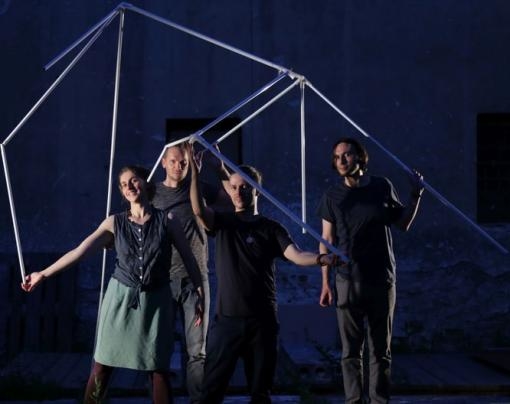Those who were captivated by the introductory distinctive song with surrealistic lyrics Z ježatých hor [From the Spiky Mountains] on the previous album of the Brno group Budoár Staré dámy [Boudoir of an Old Lady] (Sůl [Salt], 2017), can rejoice. The collaboration with the contemporary poet Lubor Kasal that began only three years ago has now resulted in an entire album of his texts set to music. However, the songs on the new album Kostřičky [Little Skeletons] have one more characteristic in common: the production and arrangement contribution by the multi-instrumentalist Tomáš Vtípil.
Vtípil has moved the songs of Marta Kovářová and her fellow players remarkably forward. Of course, this does not mean that everything is different on the new album. Above all, the rock energy associated with the typical "nervous" rhythm is noticeable from the first song A než tě opustím [And before I Leave You] to the last piece named Přibitý (Dobře si přece žiju) [Nailed (I'm Actually Living Well)]. The line-up of the band itself has not changed since the previous album. The rhythm section of Tomáš Ergens (bass guitar) and Ladislav Šiška (drums and percussion) propels the songs forward, and in addition to indisputable accuracy and harmony, they still count on intentional irregularities – stop times and other surprises inside the compositions. Marek Laudát's guitars remain the glue that connects the distinctive voice of the singer Marta and the rhythmic "undercurrents". And yet there are several things that are different here. It is not only a relatively large proportion of guest musicians, including Broněk Šmid on bassoon, Pepa Hřeben on trumpet or female voices of Lucie Krpalová (Prune) and Vladivojna La Chia. Producer Vtípil himself added the flugelhorn, accordion, violin and other instruments in the individual songs, and samples, synthesiser, distinctive piano and some less common "percussion" like a wooden beam also have their place here. However, the producer's intervention is not only heard in the choice and combination of tone colours. In the song Písek [Sand], for example, Vtípil completely breaks the anticipated "rock" structure of the song and moves the whole closer to the current electronic scene.
With the musical move forward – and perhaps with a different sound mixing technology (Tomáš Vtípil again) – it was as if the timbre of the singer's voice changed slightly. Although Marta Kovářová remains herself in articulation and expressiveness, at the same time she sometimes seems to have moved more towards Iva Bittová's position in the band Čikori. This comparison – however inaccurate – is underlined by the use of the flugelhorn or trumpet in some of the compositions. New and less common combinations of instruments, by the way, are of benefit for the album and the new sound of Budoár in general – see Pustopad with the bassoon, an interesting play of percussion and laughter as an instrument sui generis.

While the previous album could be criticised for a certain inconsistency in the lyrics (musically, however, Sůl was more consistent than the new album Kostřičky), this time you can enjoy the unconventional imagery of Lubor Kasal from the beginning to the end of the album. An important topic of the current court lyricist of Marta Kovářová is corporeality – not in the erotic but rather in the animal sense. "Brouci-hemžíci běhají ve mně. […] Už dlouho si ze sebe tahám / jenom samé kostřičky." ("Swarming beetles run around inside me. […] I've been pulling only little skeletons / Out of myself for a long time.") "Tak sem lezou tělo z těla všechna zvířata / zadávená sežraná a zase znovu počatá." ("So all the animals crawl body out of body here / Choked, eaten and procreated again.") "Aby ti mé / vykrmené krákorání / nakrabacené na koberci / svléklo prsty z nohou / a nohy z těla / a tělo z hlavy." ("So that my / Fattened croaking / Crooked on the carpet / Take off your toes from your feet / And legs from your body / And your body from your head.") "Z rosy vytečou moje vosy / vypískne užovka-píšťala." (My wasps will leak from the dew / A grass snake will shriek.") "Bambule kulichy zmijovky hadi na sněhu / průsvitní ještěři spouštění z okapů." ("Bobbles caps vipers on the snow / Translucent lizards descending from gutters.") "Slimák se tu plazí plazí / senem lesem kolomazí." ("The snail is crawling crawling here / Through the hay, through the forest and through the tar.") Each quote is taken from a different song. And at the same time, as if all the crawling and swarming of invertebrates, reptiles and other animals with and without skeletons, or even living objects, corresponded to the musical component of the album. A jerky rhythm, singing with an emphasis on each individual beat (Něco z Apokalypsy [Something from the Apocalypse]), the intertwining of individual instrumental lines – all this seemed to correspond with Kasal's poetic images, which can be imagined as if painted by one of the old master painters, headed by Hieronymus Bosch.
There is no need to ask whether the main connecting element of the album is in Kasal's lyrics or rather Vtípil's production and – probably even more so – post-production. It is the intertwining of all this together, including the arranger's ideas, that makes Kostřičky a truly significant achievement on the Czech music scene. The claim that rock music has nowhere much to develop is refuted by Budoár staré dámy with Tomáš Vtípil in several different ways. Thus it will be all the more interesting to follow the further development of the band. Even if next time the band decides to return to a rougher rock sound with a smaller share of post-production, it can be assumed that at least the "little skeleton" of this year's project will remain visible in future works.
Budoár staré dámy – Kostřičky, publisher: Indies Scope 2020. 12 tracks, total playing time: 42:22































No comment added yet..